
This resource provides a timeline chronology starting on January 30, 1933 and ending November 1, 1946.
- Subject:
- Social Studies
- Material Type:
- Reading
- Date Added:
- 12/01/2023

This resource provides a timeline chronology starting on January 30, 1933 and ending November 1, 1946.

A video [0:40] of James Wright telling of his experience as he witnessed the bombing of Pearl Harbor.

Outlines Japanese history from 1915-1945. There are also many links to other information about Japan.
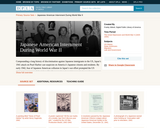
This collection uses primary sources to explore Japanese American internment during World War II. Digital Public Library of America Primary Source Sets are designed to help students develop their critical thinking skills and draw diverse material from libraries, archives, and museums across the United States. Each set includes an overview, ten to fifteen primary sources, links to related resources, and a teaching guide. These sets were created and reviewed by the teachers on the DPLA's Education Advisory Committee.
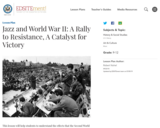
Learn about the effects that the Second World War had on jazz music as well as the contributions that jazz musicians made to the war effort. This lesson will help students explore the role of jazz in American society and the ways that jazz functioned as an export of American culture and a means of resistance to the Nazis.

Essay describing how many Jewish people in Germany did not initially believe reports of Jewish extermination due to Nazi control of the press.

Actual footage [24:29] from inside the U.S. military planning room from Department of Defense depicting wartime strategies and planning session, Tokyo targets and various bomber planes during WWII.

This is the account of Nikolai G. Kuznetsov on the end of the war. He was the Admiral of the Fleet of the Soviet Union, and a participant in the Yalta Conference.

Although antiwar organizations existed even before World War I, it was during the interwar period that pacifism became the fastest-growing movement in America. Numerous American politicians, businessmen, journalists, and activists made proposals for multilateral agreements on arms control and collective security. Through an examination of memoirs, photographs, and other primary source documents, students examine the rise of antiwar sentiment in the United States, as well as some of the concrete measures taken during the 1920s to prevent the outbreak of future wars.
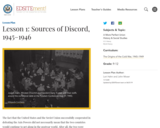
The fact that the United States and the Soviet Union successfully cooperated in defeating the Axis Powers did not necessarily mean that the two countries would continue to get along in the postwar world. This lesson will examine the U.S.-Soviet disagreements regarding Germany and Eastern Europe.
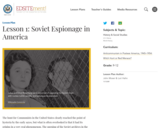
The hunt for Communists in the United States clearly reached the point of hysteria by the early 1950s, but what is often overlooked is that it had its origins in a very real phenomenon. This lesson will expose students to recently declassified FBI documents and transcripts of the Rosenberg trial. It will encourage them to think seriously about the extent of the Soviet espionage network in America, thus setting the stage for a proper understanding of later hearings by the House Un-American Activities Committee and Joseph McCarthy.
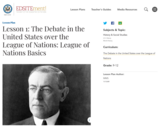
American foreign policy resonates with the same issues as the debate over U.S. entry into the League of Nations-collective security versus national sovereignty, idealism versus pragmatism, the responsibilities of powerful nations, the use of force to accomplish idealistic goals, the idea of America. Understanding the debate over the League and the consequences of its ultimate failure provides insight into international affairs in the years since the end of the Great War and beyond. In this lesson, students read the words and listen to the voices of some central participants in the debate over the League of Nations.
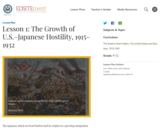
Using contemporary documents, students in this lesson explore the rise of animosity between the United States and Japan which began with Japan's "Twenty-One Demands" on China during World War I, and continued through the Manchurian Incident of 1931.
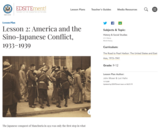
The Japanese conquest of Manchuria in 1931 was only the first step in what became a much larger campaign to create a pro-Japanese "buffer state" in North China. This lesson will examine the overall principles which underlay both Japanese and American foreign policy in the mid- to late-1930s.
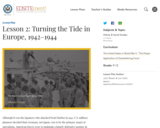
Although it was the Japanese who attacked Pearl Harbor in 1941, U.S. military planners decided that Germany, not Japan, was to be the primary target of operations. This lesson plan will focus on the overall strategies pursued by the Americans and their British allies in the initial months of World War II in Europe.
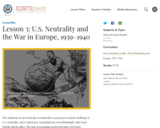
The outbreak of war in Europe in September 1939 posed a serious challenge to U.S. neutrality. On the one hand, Americans' sympathies lay overwhelmingly with Great Britain and its allies; on the other hand, public sentiment overwhelmingly favored staying out of the war. Through a study of contemporary documents, students learn about the difficult choices faced by the Roosevelt administration during the first fifteen months of World War II, culminating in the decision to provide direct military aid to Great Britain.
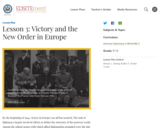
By the beginning of 1944, victory in Europe was all but assured. The task of diplomacy largely involved efforts to define the structure of the postwar world. Why and how did the United States attempt to preserve the Grand Alliance as American diplomats addressed European issues?
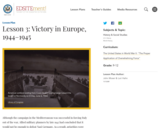
Although the campaign in the Mediterranean was successful in forcing Italy out of the war, Allied military planners by late 1943 had concluded that it would not be enough to defeat Nazi Germany. This lesson plan will focus on the overall strategy pursued by the Allies in the final months of World War II in Europe.
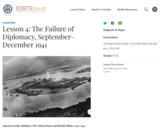
Faced with crippling economic sanctions imposed by the United States, the Japanese government decided in September 1941 to prepare for war to seize the raw materials that they were now unable to obtain from America. Students in this lesson will put themselves in the shoes of U.S. and Japanese diplomats in the final months of 1941.
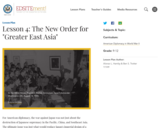
For American diplomacy, the war against Japan was not just about the destruction of Japanese supremacy in the Pacific, China, and Southeast Asia. The ultimate issue was just what would replace Japan's imperial design of a "Greater East Asia Co-Prosperity Sphere." This lesson plan focuses on two major postwar problems"”the future of China and (using French Indochina as a test case) the future of Western imperialism in Southeast Asia.